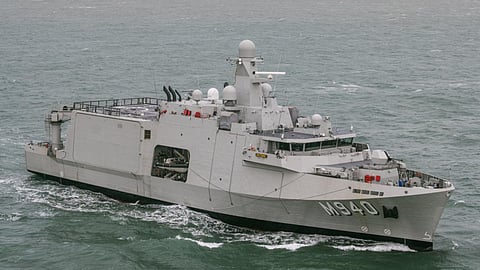VESSEL REVIEW | Oostende – Belgian Navy's new mothership for unmanned minehunting craft
French naval shipbuilding joint venture Kership and the Belgium Naval and Robotics consortium have completed the first vessel to be built under the joint Belgian-Dutch rMCM mine countermeasures (MCM) program.
Twelve ships will be built under the rMCM program with the Belgian and Royal Netherlands Navies receiving six vessels each. For the Belgian Navy, the lead ship is Oostende, named after the Flemish coastal city, and all six ships for Belgium will be known as the City-class.
Kership is in charge of the production of the twelve platforms, which are assembled in Concarneau and Lanester. They will be then all armed afloat by Piriou in Concarneau. The Naval Group, as overall architect and prime contractor, is responsible for the design of the ships, the overall integration, and the testing and commissioning of the mission system, which includes the combat system and the mine countermeasures system.
The maintenance of the ships will be carried out in Belgium as part of a close collaboration between the Belgian Navy and Naval Group Belgium. Assistance will be provided by Flanders Ship Repair.
Able to house an assortment of unmanned MCM vehicles
Oostende has a length of 82.6 metres (271 feet), a beam of 17 metres (56 feet), a displacement of 2,800 tonnes, a crew complement of 63, a maximum speed of 15.3 knots, and a range of over 3,500 nautical miles.
Space is available for two seven-metre rigid inflatable boats and their launch and recovery systems in a specialised mission bay as well as 15-tonne and three-tonne handling cranes for the deployment and recovery of both manned and unmanned and unmanned vessels.
The ship will be able to launch and recover autonomous underwater vehicles fitted with sonars; towed sonars; unmanned aerial vehicles; and unmanned surface vehicles (USVs) of up to 12 metres and 19 tonnes each. The USVs themselves will be able to launch and recover remotely operated vehicles equipped with mine identification/destruction systems.
Some of the unmanned vehicles and their systems were supplied by Exail, one of the two partners in the Belgium Naval and Robotics consortium.
Fitted with technologies for safe mine disposal
The solution acquired by the Belgian and Dutch navies will see each ship and ship's control and mine-fighting personnel remaining at a safe standoff distance from any identified mines. The Naval Group said this solution also means that the speed with which the mined area can be dealt with is ten times faster than with conventional means.
The MCM vessel will use a fully robotised system to detect, classify, identify and neutralise mines. The ship can withstand underwater explosions and also boasts significantly low acoustic, electrical and magnetic signatures, in line with the missions to be carried out.
The ship’s crew facilities also include a galley, a mess, and a gym.
Oostende was handed over to the Belgian Navy in November 2025. All other ships in the class are scheduled for delivery through the middle of 2030. Vlissingen, the second ship in the class overall and the first slated for the Netherlands, is tentatively scheduled to be delivered by the end of this year.


